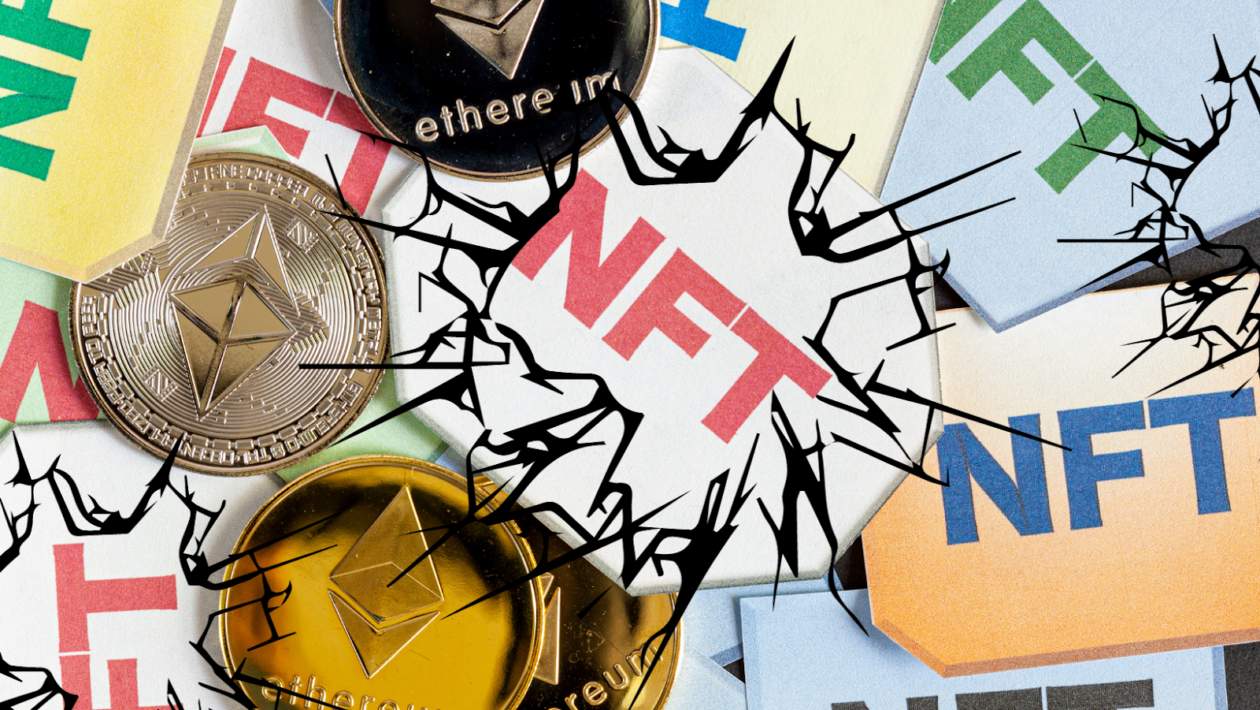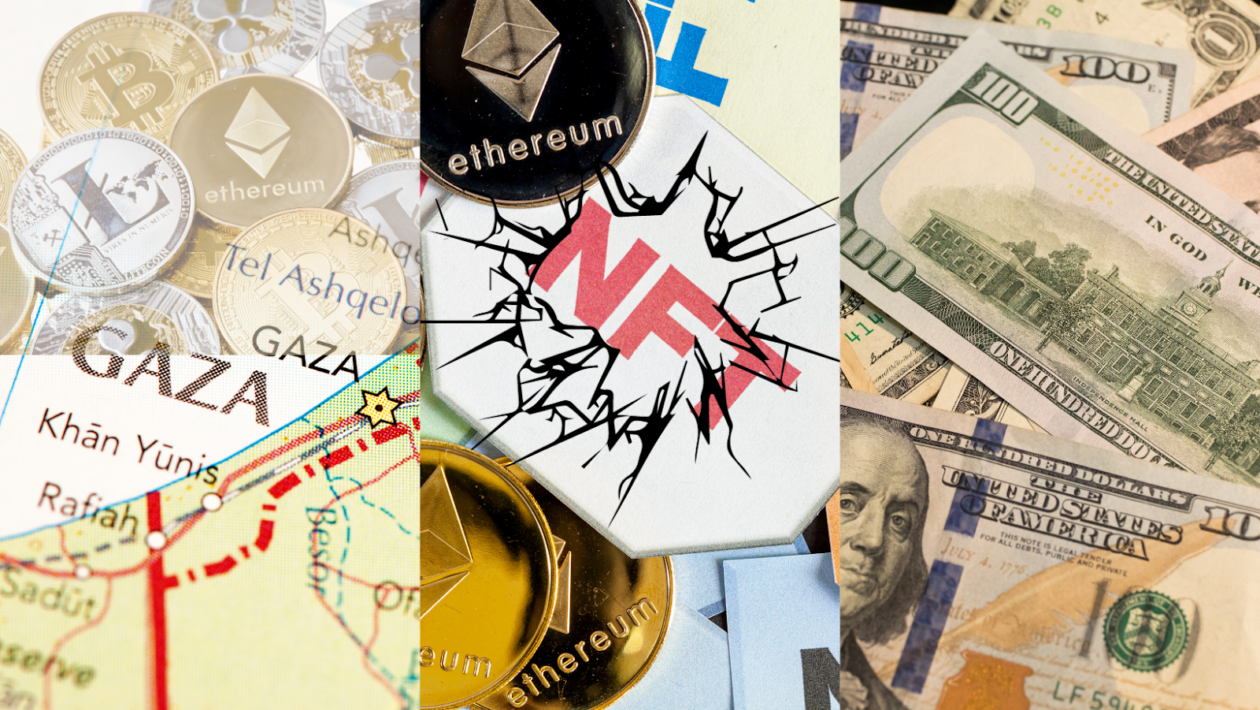In this issue
- Gaza tensions, digital tremors
- NFTs: not dancing in September
- Lubin talks twilight: Traditional system’s eclipse
From the Editor’s Desk
Dear Reader,
It’s a geopolitical conflict with roots stretching back over more than a century. Yet the latest escalation of violence in Israel and Palestine this past week feels particularly shocking. Not least because the Hamas-led attacks throughout Israel over the weekend apparently caught the Israeli government, intelligence services and military — one of the world’s most well-provisioned — completely off-guard.
Reports have emerged suggesting that the militant group Hamas, the de facto political leadership in the Palestinian region of Gaza, used crypto transfers to raise millions of dollars in funds for the weekend’s attacks. It therefore appears we have once again seen financial access weaponized, as it always is in modern day conflict.
The hope now is that crypto steps up to take on a more positive role in what happens next. The blockchain, after all, is advertised as stateless, and permissionless. In its truest guise, it bypasses politics. It could be used here to get much needed humanitarian aid to civilians on both sides of this bloody conflict.
Local Web3 entrepreneurs set up an emergency crypto fund for Israeli victims of the violence — a move that we applaud and recommend readers seek out. But there are also more than 2 million Palestinian civilians inside Gaza who could benefit from financial aid delivered in the form of crypto.
As we have seen in this abhorrent incursion, civilians have cruelly been included in the attack equation. From afar, the complex web of history, politics, and homeland intertwine. On the ground, there are simply lives at stake.
Until the next time,
Angie Lau,
Founder and Editor-in-Chief
Forkast.News
1. Crisis? Bitcoin’s dual response

Israel’s cyber crimes unit, in conjunction with the National Headquarters for Economic Warfare, has announced the freezing of cryptocurrency accounts believed to be instrumental in raising funds for the Gaza-based Palestinian militant group, Hamas.
- Israeli authorities have reportedly urged Binance, the world’s largest crypto exchange, to transfer the confiscated funds into Israel’s state treasury.
- That follows a devastating series of attacks on Israel by Hamas over the weekend. The attacks, which included multiple atrocities against civilians, killed an estimated 1,200 people and wounded at least 2,700 others as of noon Thursday in Hong Kong.
- In retaliation, Israeli warplanes have bombarded Gaza, a tiny strip of land some 40 km in length and home to over 2 million people. The air strikes have reduced large parts of the area to rubble, with 900 people reported killed and 4,500 injured. Reports indicate that the Israeli military has called up 350,000 reservists and may now be preparing for a ground assault on Gaza.
- In response to this humanitarian crisis, a consortium of Israeli crypto companies has launched Crypto Aid Israel. This emergency fund aims to support Israeli citizens affected by the ongoing conflict. It is spearheaded by local crypto industry figures and companies such as Fireblocks, 42Studio, Market Across and CryptoJungle. They have teamed up with non-profit organizations to receive and deliver humanitarian aid to affected Israeli communities using cryptocurrencies such as Bitcoin, Ether and stablecoins like USDT and USDC.
- Crypto has been used in conflict before. On-chain data shows that combatants and civilians on both sides of the Russo-Ukrainian war make use of cryptocurrencies as a way to receive and send funds. The use of crypto on both sides of the divide reveals crypto’s dual-edged nature as a tool designed to increase financial access, regardless of political affiliation, location, or intended use.
- Six months into the conflict with Russia, Ukraine had already raised US$54 million in crypto donations, channeling it towards the provision of military essentials, medicine, and vehicles for their armed forces. On the flip side of that, pro-Russia militias also received over US$20 million in cryptocurrencies in the first year of the conflict.
Forkast.Insights | What does it mean?
The Middle East, as a pivotal hub for global oil production and transit, has long been a focal point of geopolitical tension reverberating through the global economy. When conflicts arise in the region, the immediate concern for markets is often the threat to oil supply chains. Physical infrastructure can be damaged, while fear of wider escalation stokes market uncertainties. Locations like the Suez Canal and the Strait of Hormuz become choke points for global oil supply.
However, the market impact is felt beyond the oil sector. Rising oil prices lead to higher transportation and production costs. As these costs surge, consumers feel the pinch, leading to inflationary pressures. Central banks, in a bid to stabilize economies, adjust monetary policies, which in turn further fuel inflation.
In the midst of these economic fluctuations, investors begin to search for stability. Historically, this stability was sought in gold, a time-tested “safe haven.” However, the digital age has ushered in another contender: Bitcoin.
Dubbed “digital gold” by some, Bitcoin offers certain features that make it attractive in times of uncertainty. Its capped supply makes it a potential hedge against fiat currency depreciation, especially at times of high inflation. Additionally, in regions with limited banking, the decentralized nature of Bitcoin can offer an alternative means of accessing financial services.
But Bitcoin’s journey amid geopolitical unrest is not a straightforward one. While some investors view it as a refuge, others might liquidate volatile assets like cryptocurrencies to cover losses or rebalance portfolios. This duality in investor sentiment can lead to sharp, unpredictable price movements in the Bitcoin market. On top of that, as Bitcoin’s ecosystem intertwines with the broader economy, significant spikes in global oil prices could impact the energy-intensive process of Bitcoin mining, affecting its network dynamics.
2. Wake me up when September ends

The NFT production on Ethereum reached an all-time low of US$17.55 million in September, marking a 12.4% decline from August’s US$20.05 million, according to data from Forkast Labs.
- Prestigious NFT collections like Bored Ape Yacht Club and CryptoPunks saw a significant drop in their valuation, pointing to a potential shift in the broader market sentiment.
- Forkast ETH NFT Composite, an index tracking the top 250 NFTs on Ethereum, plunged 48% year-to-date, hitting its low of 715.22 points in September.
- Polygon’s NFT production experienced a dip, with September’s figures at a seven-month low of US$4.7 million. That was, nonetheless, an overall year-to-date increase of 219%.
- Anndy Lian, NFT author, suggests the NFT hype from 2021 has tapered off, leading to a selective and realistic approach from buyers.
- Major NFT marketplaces like OpenSea and Blur reported drops in monthly trading volumes by 31.8% and 38.3% respectively in September.
- While the market faces challenges, global brands like Starbucks are still adopting NFTs, showcasing new innovative use cases that could reignite interest in the sector.
Forkast.Insights | What does it mean?
There has been a fundamental shift in the way NFT investors collect and trade. They’re finally looking for real value.
Where they aren’t finding value is in new mints, currently at all-time low NFT production levels. Those new NFT mints typically represent run of the mill profile picture collections, which can make creators enormous profits in an instant during a bull market. Today, you’ll be lucky to flip a new mint for what you paid.
After major projects like the CyberKongz’ Genkai, and NWay’s Wreck League failed to sell out their primary sale over the summer, creators hit the brakes on minting new collections.
Still, even with declining primary sales and plummeting value for NFTs on secondary markets, some NFT collections are proving resilient even today. Those collections offer more tangible value, like the Pudgy Penguins NFTs who offer royalties on toy sales to select NFT holders.
Similarly, the Winds of Yawanawa collection by Refik Anadol offers a more abstract, but equally attractive value as pure art. Refik’s art has been featured both on the Las Vegas Sphere, and now in the Museum of Modern Art as the first NFT creator to have his NFT backed digital art welcomed into their collection.
Even more value has been uncovered in new SoFi (social finance) platforms, which have themselves been a main contributor to the decline of the NFT markets. Total new users of the new Friend.tech platform have climbed to over 299,000 unique users, up from 130,000 on Sept. 1. Total locked value in the platform also rose from around 3,260 ETH to approximately 29,200 ETH over the month of September.
Innovation is for now mostly coming from outside NFTs. Until it returns to the non-fungible token market, expect to see September’s trend of all-time-low sales to continue well into October and beyond.
3. Monetary system’s impending sunset

Joe Lubin, chief executive of blockchain technology platform Consensys and a co-founder of Ethereum, spoke to Forkast during the recent Token2049 conference in Singapore. He discussed the parallels between today’s crypto bear market and the dotcom bubble of the late ’90s. Lubin attributes the current crypto downturn to similar waves of unbridled enthusiasm followed by market corrections. He predicted that a marriage between AI and blockchain could be the crypto industry’s route back to prominence.
- Amid escalating global financial challenges, such as inflation and interest rate hikes, Lubin said that traditional monetary systems might be approaching their twilight.
- Regulators in the U.S. are scrutinizing the crypto industry. Lubin sees this as a veiled effort to either “slow-roll” or outright suppress the budding industry.
- Looking abroad, regions like Europe, Asia, and the Middle East are painting a contrasting picture. Those regions, he said, see decentralized tech as an equalizing force against the might of U.S. financial power.
- A tech marriage is on the horizon, Lubin said. He highlighted the importance of weaving artificial intelligence into the fabric of blockchain technology — and vice versa.
- There’s no need for society to be overly concerned about artificial intelligence, according to Lubin. He remains buoyant about AI’s potential, particularly in collaboration with decentralized protocols that prevent the concentration of AI control in a small number of hands.
Forkast.Insights | What does it mean?
Lubin is no AI doomer. He made that clear during his interview with Forkast. But while the blockchain mogul and Ethereum godparent outlined a lot of the good that can come from AI’s impending global takeover, he touched on some of its more dystopian aspects also.
Tech is never inherently bad, was the primary thrust of Lubin’s argument on artificial intelligence. The Consensys boss should know. He graduated from Princeton with a degree in computing and electrical science before kicking off his working life in the university’s robotics lab. So he enjoys a pretty solid grasp on the nascent field.
The only danger of artificial intelligence, he said, is if those now working on it allow its power to become entirely concentrated in a small number of hands — the bevy of private companies driving much of today’s AI advances. That would be “failure mode for humanity,” he said, without so much as a flinch.
The remedy for that, Lubin argued, is open source building and the incorporation of decentralized blockchain protocols. That way, the capabilities explored on the back of large language models (LLMs), generative pretrained transformers (GPTs) and the like will remain visible for all to see and make use of.
Your next open source coding tutor? Look no further than AI.
“We need to level up humanity in a big way,” Lubin said. “Our AI allies are going to get better and better at that.”




